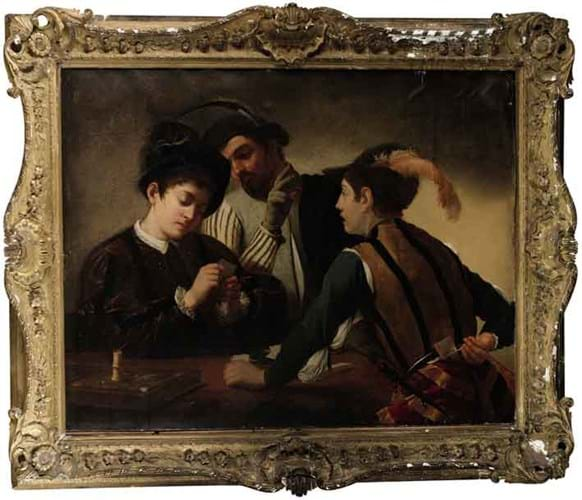
The auctioneers, who had sold the picture catalogued as by a 'follower' of Caravaggio for £42,000 at their Olympia saleroom in 2006, are now claiming costs of £3.75m against the plaintiff, Lancelot William Thwaytes who had originally consigned the work. After being awarded an initial payment of £1.8m they now awaiting a further ruling on the matter by the judge, Mrs Justice Rose.
The case arose after the late collector, art historian and acknowledged Caravaggio scholar Sir Denis Mahon, who acquired the picture at the 2006 sale, went on to identify it as an original Caravaggio. Sir Denis died aged 100 in 2011 and the picture is now on display at the Museum of the Order of St John in Clerkenwell. It is apparently insured for £10m.
Mr Thwaytes' claim for negligence and breach of contract centred on whether the auctioneers carried out enough research into the picture and whether they advised their client properly in relation to the painting.
Expert Opinion
During the court hearing, a number of academics gave their expert opinion including Professor Richard Spear of the University of Maryland, who agreed with the unanimous view of Sotheby's specialists that this work was an anonymous copy of Caravaggio's original which is now in the Kimbell Museum in Texas.
Mrs Justice Rose dismissed the claims against Sotheby's outright. Her judgment states that while both parties admitted that there is "no single ultimate authoritative voice on the attribution of Caravaggio as there is with some artists", she was "firmly of the view that Sotheby's were entitled to come to the view that the quality of the painting was not sufficiently high to merit further investigation".
The case was also dismissed on the following grounds:
• Sotheby's were entitled to rely on the connoisseurship and expertise of the specialists in their Old Master department in assessing the quality of the painting. The specialists were highly qualified and examined the painting thoroughly at two separate meetings
• Sotheby's reasonably came to the view that, on the basis of what they saw, the quality of the painting was not sufficiently high to indicate that it might be by Caravaggio.
• There were no features of the painting visible under either ordinary or ultra violet light that might have suggested 'non-copy features'. Sotheby's specialists also reasonably came to the view that there was nothing in the X-rays of the work that should cause them to question their assessment based on quality.
• Sotheby's were not under any obligation either to carry out infra-red analysis of the painting or to advise Mr Thwaytes to arrange for that to be carried out. If they had carried out infra-red analysis they would not have found anything in the infra-red images that should cause them to question their assessment of the painting.
• The auctioneers were not negligent in failing to inform Mr Thwaytes about the interest shown in the painting once it had been put on view at Olympia. If they had informed him of this, the judge was satisfied that Mr Thwaytes would not have withdrawn the painting from sale since he would have been informed that all the Sotheby's experts were certain that the painting was a period copy and not by Caravaggio.
The judge also ruled that, even if it could have been shown that Sotheby's had not sought the appropriate level of external advice, the level of financial loss would not have been great.
Even if Sotheby's had consulted the scholars listed in the claim who would have suggested a positive attribution and their opinion was mentioned in the catalogue entry, the negative view expressed by other scholars would have carried more weight, she added, concluding that while it "would have made slightly more at auction or by private treaty", it would not have made "a great deal more".
Who will pay the costs?
The Card Sharps case pitted two of London's top law firms up against each other - Boodle Hatfield acting for Mr Thwaytes and Freshfields Bruckhaus Deringer representing Sotheby's.
Having won the case, Sotheby's are now claiming full costs of £3.75m.
At the High Court hearing on January 16, the judge awarded an interim payment of £1.8m before a further ruling on costs will be made at a later date. Sotheby's are also claiming indemnity costs, arguing that the claimant had adopted an "unreasonable conduct" through an "excessive proliferation of the issues" and "ill-considered comments regarding Sotheby's conduct".
As well as having to pay Sotheby's costs, it is thought that Mr Thwaytes's own legal bill will also run into the millions. However, it emerged at the hearing that the claimant had 'third-party commercial litigation funding' as well as insurance cover.
At the hearing, Sotheby's sought to reserve the right to recover costs from the third parties should their costs not be met by the claimant's insurance. The judge agreed.
Will Thwaytes appeal?
While the judgment of Mrs Justice Rose would seem to give little grounds for appeal, the claimant's lawyer said that they would make a considered assessment in due course on this matter. At the hearing, they mentioned that there might be some grounds for appeal regarding the issue of whether infa-red analysis should have been applied.
Interestingly, they also pointed to the upcoming sale of a separate work catalogued as by Caravaggio being offered at Christie's New York this month, and said they will wait to see the outcome of this auction before deciding whether to seek permission to appeal.
The work at Christie's, Boy peeling a fruit, is estimated at $3m-5m and will be offered on January 28.
Over the years its attribution has generated considerable academic debate as to whether it is an original or a copy.





